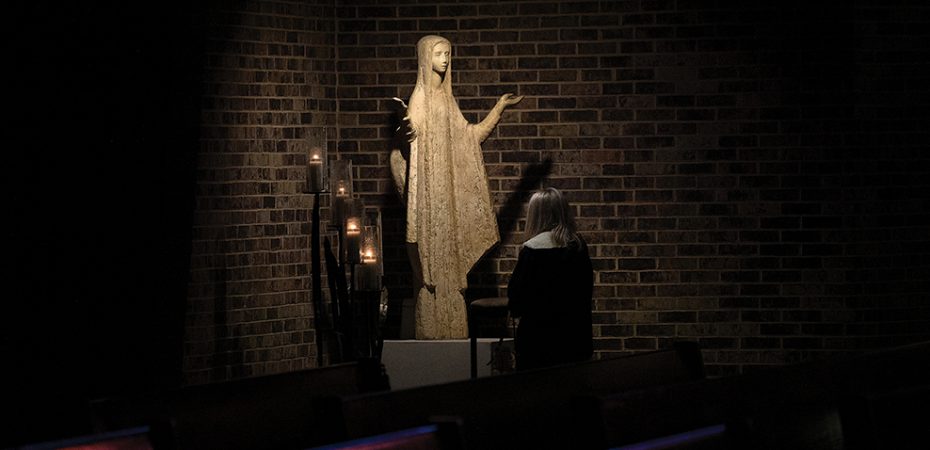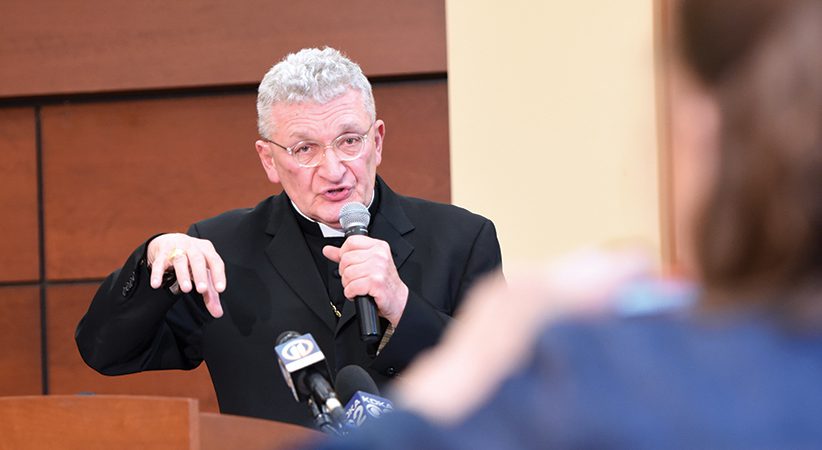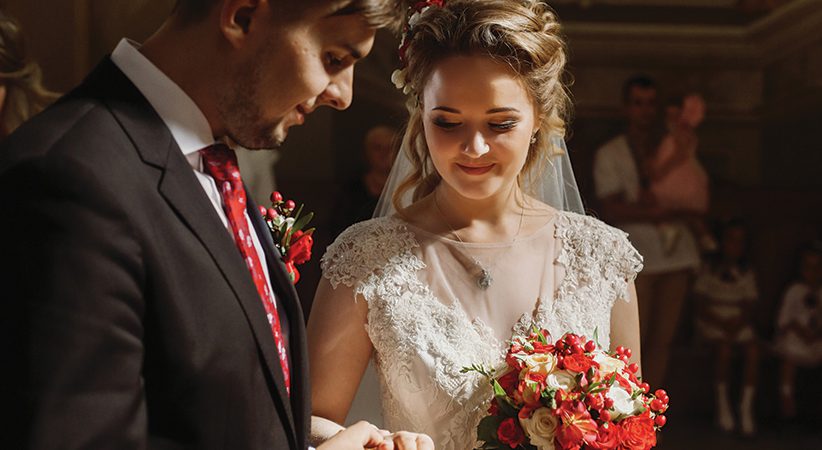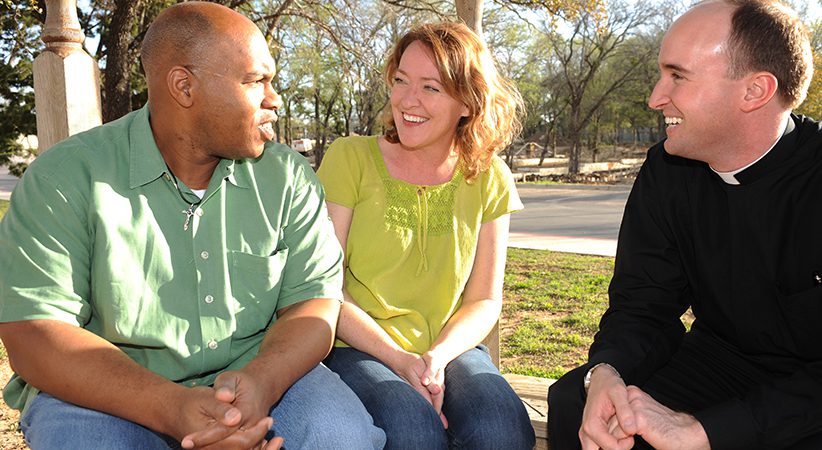The Trauma of Child Sexual Abuse
Many throughout the Church have been wounded by abuse and the scandal it has caused. But in Christ, all can be healed.
Father Kenneth W. Schmidt Comments Off on The Trauma of Child Sexual Abuse
The trauma was not only caused by priests; it includes all clerical orders and other Church personnel. It’s not just a problem in the United States or the Northern Hemisphere; it’s worldwide.
It’s not only sexual abuse. We now recognize that power, position and a presumption of privilege can result in sexual, verbal and emotional abuse. Nor is it limited to children. People are now much less willing to excuse any inappropriate sexual behavior with adults by the clergy. Even if it was thought to be consensual, we now understand that sexual behavior is shaped by the dynamics of power, respect and a partner’s difficulty or inability to say no or preserve boundaries because of their own history.
A relentless number of stones, rocks and boulders have been cast into the Church’s pond, causing ripples, waves and crashing surf to come ashore. Who are affected by this upheaval and its ongoing consequences?
Survivors/Victims
We must continue to hold in our care and our prayer the children, many who are now adults, who were sexually abused by clergy and other Church personnel. The effects are deep, and they are long-lasting; they don’t disappear just because a child grows up. Children are not to blame; it was not their fault and not under their control. Finger-pointing, interrogating and blaming victims for their abuse simply adds new wounds to the old ones. Victims’ decisions not to tell is rooted in fear, threats and the potential consequences of losing significant relationships or positions, all of which can feel life-threatening.
We also hold in our prayer other survivors who were adults when they were abused by clergy, and all other victims of abuse. The initial circumstances may be different, but the dynamics are the same: power over victims, their fear of the consequences if they tell, and often a belief that the abuse is their fault. With all the publicity about abuse within the Church, we should remember that it triggers painful memories and emotions for other abuse survivors even if their perpetrators were not clergy.
Survivors choose a variety of ways to get through their horrific situations at the time, and what follows for years after. After boundaries are trespassed and their bodies are violated, their trust is destroyed, their confidence is trounced, and their faith is shattered (by a representative of God, no less). So they create rules of survival for themselves, which are very hard to give up. Most of them learn to manage their lives, sometimes showing heroic strength and courage, while still carrying a heavy burden.
Parents and Family Members of Victims/Survivors
The responses of people in this category are often tied to a sense of powerlessness, unable or not knowing how to help. They may have been unaware at the time that the victim was being harmed; they may have had some inkling but not acted on it; they may have asked the child and were told that “nothing was wrong”; they may have been told, but denied it or accused the child of making it up or lying. Years later, they may still wonder how they could have protected their child or sibling. Some may have believed the denials of the abuser.
All of these responses can lead to feelings of guilt, which also need attention and healing. As the victims move into adolescence and adulthood, their behavior may become problematic, and the family members don’t know why it’s occurring or how to help. Along with behavioral issues, addictions or suicide may ensue, and more pain is heaped upon the family. Family members are a mostly overlooked population of people who are suffering.
Rescuers/Failed Rescuers
These are people who could have or should have responded. The leaders of the Catholic Church are failed rescuers. The people who saw hints of abuse or received allegations but took no actions failed the children. Those who resisted the truth, who didn’t believe a child who told what was happening, failed those children. The people who ignored what was happening or covered it up failed the children. Those who allowed abusers to continue to have access to children failed them. The police and attorneys and court officials who let it pass or looked the other way rather than charge and prosecute criminal behavior failed the children.
In the minds of childhood trauma survivors, there is another failed rescuer — God! “You say that God loves me, and watches over me and will protect me. So where was God? Why did God let this happen?” When the abuser is a member of the clergy, the confusion is deepened. Is it any wonder that the survivors are angry at God and the Church?
Clergy (and All Church Personnel)
They have a multitude of reactions because they live in the same Church and society as everyone else. They also bring their own personal experiences, which inform their opinions.
Their responses include:
• Shock and shame when they discover what friends, classmates or clergy-heroes have done.
• Guilt and regret because they had suspicions or saw something and did nothing.
• Anger and frustration about how their ministry is hampered now because people look at them with fear and suspicion.
• Fear, maybe even paranoia, because at any moment someone can make an allegation just because of a disagreement or anger.
• Hesitancy and inadequacy about how to respond. So their response may be to make no response.
• When they feel angry, hurt and inadequate, their emotions may get expressed as depression, blaming or inappropriate behavior.
Bishops
First, not all bishops followed their own protocols and legislation, which resulted in more children being hurt. In addition, many bishops now in office are dealing with the actions of their predecessors rather than their own responses to victims. We should also pay attention to historical context — was a bishop acting in good faith based on the information available to him at the time, or was he acting independently or even arrogantly? In the last 20-30 years, psychological experts and bishops have advanced significantly in their understanding of both abusers and survivors.
Second, bishops are in a double bind, required to relate to their priests as a father figure and as a colleague, which is commendable and helpful. But in fulfilling these roles, bishops sometimes lost sight of their primary role as shepherd to the people entrusted to their care. The media are not reporting cases when our shepherds responded to victims with care, urgency and support.
| Pope Francis |
|---|
|
“Christ himself, in fact, has entrusted us
with the care and protection of the weakest
and defenseless: ‘Whoever receives one child
such as this in my name receives me’ (Mt 18:5)”.
— motu proprio, “On the Protection of Minors
and Vulnerable Persons”
|
Third, new rules hold bishops responsible if they fail to respond when they receive allegations. Parallel to the situation of other clergy, anyone can come forward and make an allegation. So there is more vulnerability and fear among bishops.
Last, it once seemed that bishops were solidly united and walked in lockstep, at least publicly. Now Pope Francis has encouraged them to speak more openly, such as at bishops’ synods. Respectful sharing is healthy. But we see division and even aggressive disagreements among them. There is name-calling, meanness and sniping, disputing one another’s orthodoxy, even questioning the pope himself — more troubling effects of the ongoing tragedy.
Parishes, Dioceses and Local Communities
Along with individuals who suffer harmful effects, our corporate entities also bear pain, wounds and scars. Where abusive Church personnel have been named or removed, parishioners may divide into groups of those who support the perpetrator and those who want to punish. Parish members may scapegoat the bishop, the media, those who reported the abuse and even the victims themselves. Others simply walk away, and the Body of Christ is the poorer. The wider communities are also damaged, as they listen and watch their friends and neighbors’ varied responses. Finally, the moral influence that the Catholic Church enjoyed has severely eroded. The effects appear in American society, and worldwide, as the curtain is drawn on a universal problem that is more widespread than most people are aware of or willing to admit.

Perpetrators
To engage in sexual abuse is an act of power over the victims regardless of their age or gender. It is an exercise of domination and violence. One thing to note is that those who sexually abuse children are often themselves victims of childhood sexual abuse. (That does not mean that those who are victims of childhood sexual abuse are destined to become abusers.) As abuse survivors, they may be trying to manage their own feelings, such as vulnerability and helplessness; in no way does that excuse their behavior. They are still responsible for their actions and must be held accountable — to civil society and to the Church.
We must also pray for them, and be grateful for God’s mercy, from which no one is excluded.
The Catholic Church Has Been Traumatized
We have named many groups among the People of God who are traumatized by the disclosure of child sexual abuse. The effects are serious, long-lasting and can pass from one generation to the next if not addressed. Here are some elements that comprise a healthy response to the trauma symptoms that exist in the Catholic Church.
Attachment Ambivalence
All human beings need attachment in order to survive. From the moment we are conceived until we reach some level of maturity and self-sufficiency, we must have others who care for us or we will not survive or thrive.
We also have another safety mechanism — an urge to detach in the face of vulnerability, fear, threat, harm, etc. We instinctively pull away in order to protect ourselves or to escape the pain or possibility of harm.
When an event interferes with our development, we can grow up with attachment ambivalence — the contrary and confusing desires to attach and detach, both driven by the same desire to survive.
There is a natural, human sort of attachment ambivalence about interpersonal relationships. We may want people close, but not too close; we desire intimacy, but at the same we time fear people invading our privacy. We have to move slowly into intimate relationships and determine with time whether we are safe and the other person is trustworthy.
There seems to be a natural attachment ambivalence about a relationship with God; we want God to be a part of our life, but don’t want God to tell us what to do; we want God close, but not too close.
A significant number of people also have an ambivalent attachment to the Church. They want to walk away, and they want to stay; they love the Church, and they are filled with anger for what has happened.
………………………………………………………………………………………………………………………………………………………..
Liturgy
The liturgical prayer of the Church has the potential to bring about significant healing. We should not ignore the means that Christ has given us in word, sacrament and sacramentals. Creative approaches of listening to victim-survivors, praying for one another, supporting recovery efforts, and expressing our repentance and seeking forgiveness are all positive ways to promote healing. These can be done individually, of course, but there is a benefit to praying together in our parishes and dioceses in order to recover from our collective wounds and sins.
…………………………………………………………………………………………………………………………………………………………
A common outcome of attachment ambivalence is attempts to avoid uncomfortable emotions. Most people acknowledge their desire to avoid at least some feelings, such as sadness, anger and fear. We also may find it difficult to hold multiple feelings, believing instead that we should have only one feeling. So we try to decide which one is the right one and then push away the others. It doesn’t work, because the other emotions still exist even when we try to ignore them. And the actions taken as a result of the selected feeling may ignore other actions that are needed.
The goal is not to overcome or be rid of attachment ambivalence, but learn to live with it, to be at peace with its existence. In a broader sense, maturing means learning to live with all ambivalence, to recognize and accept when we have multiple and contradictory feelings about people and situations. This includes complex feelings that emerge when we deal with the Church and the consequences of abusive behavior by clergy and other Church personnel.
VPR Triangle
In the process of experiencing intense and difficult emotions, our behavior may move toward extremes. The VPR Triangle is one model that describes such behaviors. When we have an intense feeling, our responses may be to follow the patterns of a victim, a perpetrator or a rescuer.
A victim response flows from thinking that victimization will continue and there’s nothing that can be done about it. Rather than wait for something to happen, we may induce or perceive abuse from others. We may act impulsively or not reflect on the potential consequences of our actions, hoping to gain some sense of control over our lives rather than feel completely helpless. Or we may continue to do the same as we did in the past, while hoping for a different outcome.
We have seen these responses from Church leaders who claim to be victimized by the media, government officials, attorneys, mental health professionals or even the abuse survivors. Rather than taking new actions, our history is to revert to the actions taken in the past, at least until pushed very hard to change.
A perpetrator response also flows from feelings of helplessness, but to the opposite extreme. Rather than feel victimized, we may be antagonistic or aggressive, causing additional harm while trying to gain some sense of control. We can rationalize this as “balancing things out” by avoiding being hurt again, while ignoring the fact that others are being hurt in the process. Church responses toward victims include blaming and scapegoating, attacks and character assassination in the media and aggressive lawsuits.
A rescuer response flows from a belief that we can do enough good to make up for the bad that has been done, or to relieve the shame or guilt we feel. We may harm or not take proper care of ourselves while trying to help others. An extreme Church response would be to give away all of its financial resources to abuse survivors, while ignoring all the other needs and responsibilities of the Church that also require its financial support.
Healthy responses do not go to such extremes. They may go in one of those directions, but without causing harm to ourselves or others. We may realize that we cannot control what has happened in the past, but we have the freedom to choose how to respond rather than simply react. We can be assertive and strive for justice, but not to an extreme that hurts others. We can provide helpful assistance while also being respectful of other needs that must be addressed.

Healing
Following the Charter for the Protection of Children and Young People, the U.S. Catholic Church has taken many steps to protect children and vulnerable adults. It has led the way for many other institutions to do the same.
The revised charter also pledges “to have a special care for and a commitment to reaching out to the victims of sexual abuse and their families” and to “continue to help victims recover from these crimes.” We have seen that there are many people who have been adversely affected besides those who were abused, and all of them need various forms of healing.
Components of healing for survivors, as well as members of the Church, include recovery, grief, forgiveness and repentance.
Recovery refers to the psychological and spiritual processes that can assist those who were abused and others who have been harmed in the aftermath. Prayer, spiritual direction, individual therapy and psychoeducational groups are some forms of dealing with the trauma and its deep and long-lasting effects. Recovery takes time and effort and brings a significant amount of relief.
Grief is a feeling that many people try to avoid. Early grief work tends to focus on the bad things that happened because of the trauma. Later, work focuses on what has been lost as a consequence. Grieving requires that we learn to tolerate and accept the profoundly painful feelings that surface. By grieving appropriately, extreme behaviors and emotions quiet, and the benefits begin to emerge externally as well as internally.
There are many good resources that help people through their grief. They can be adapted to address the particular needs of members of the Body of Christ who are suffering through this tragedy.
Forgiveness is a process in which persons who have been unjustly injured change their thoughts, their feelings and their behavior toward the ones who have caused their injuries. Notice that forgiveness is one-sided: It is what injured people do in order to foster their own healing; forgiveness is not something done to or for the one who caused the harm.
There are many misunderstandings about forgiveness — that the other person must apologize first; that the person who caused the harm doesn’t deserve to be forgiven; that to forgive means that what the person did was not wrong; that there is no need to forgive if the other person did not intend to cause harm; that in order to forgive there must be some relationship or interaction with the person who hurt me, etc. None of these beliefs is true, and they interfere with the healthy process of forgiveness.
Forgiveness requires the injured person first to acknowledge the event and also acknowledge the suffering and negative consequences that have followed. Then there must be a conscious decision to engage in the process. The injured person must gradually look beyond the immediate injury to see the perpetrator in a larger context, and from this some empathy and compassion emerge toward the offender (and for oneself if caught in self-blame and guilt). Finally, the injured party acts without a desire for revenge.
The process of interpersonal forgiveness is another means to alleviate the pain of survivors and members of the Church. With serious and devoted effort, they can take steps to relieve their negative emotions (anger, guilt, resentment, hostility, shame), and then experience a positive change in their emotional and physical well-being.
Repentance
Some of us may also need to repent and ask forgiveness from victims. Even at a distance we may have been skeptical of their reports, believed they were just trying to get money, thought their motivation was to attack or harm the Church, or thought that “they should grow up and get over it.”
Just as some people get caught in a web of memory and pain after someone hurt them (which requires forgiveness in order to heal), other people get stuck in the trap of painful memories after they have caused harm or neglected to help someone who was hurt. The process for healing oneself is repentance or self-forgiveness.
The Church will have to be a wounded healer. Many resources are available for Church personnel to bring comfort and healing to the Body of Christ.
FATHER KENNETH W. SCHMIDT is an advocate for priestly ministry and support in the Diocese of Kalamazoo, where he serves as a tribunal judge. He is executive director for Trauma Recovery Associates, a nonprofit that teaches effective treatment of childhood trauma.
………………………………………………………………………………………………………………………………………………………..
Reporting
There are laws that call for reporting to civil authorities when there is knowledge or suspicion of abuse of children and vulnerable adults. Mandatory reporters vary from state to state, and include teachers, medical personnel, mental health professionals and clergy. All of this is helpful.
However, most child abuse occurs within families. Oftentimes other family members know or have good reason to believe that a child is in harm’s way. They don’t want to get involved, or get caught up in a difficult family dynamics. This is understandable, but not helpful to the child who is ensnared in trauma. Yet family members are not mandated reporters.
Why do we not have laws that require everyone to report possible abuse? Why do we restrict mandated reporting to certain categories of people? If the excuse is that it’s hard, then we are simply choosing our own comfort or self-protection rather than caring for the one who is being hurt or neglected. The Church has discovered that such thinking has not served it well.
…………………………………………………………………………………………………………………………………………………………





